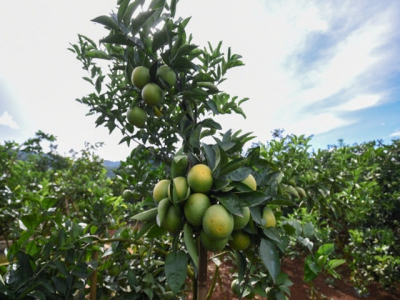Citrus trees need planning

Having been growing fast in area, yield and quality in the past few years, it is now not easy to find a sustainable direction for citrus trees.
Newly planted oranges in Son La. Photo: Tung Dinh.
Rapid growth
According to the Department of Crop Production, Ministry of Agriculture and Rural Development, citrus yields across the country have continued to increase over the years. Particularly in the North, from 2009 to 2019, the growth rate of citrus averaged 10%/year in terms of area (corresponding to 7,300ha/year), 12.5%/year in terms of yield (69,400 tons/year).
With favorable climate and natural conditions, many northern provinces have been promoting the cultivation of citrus in recent years. Nine provinces have orange-growing areas exceeding 1,000 hectares, and 14 provinces have pomelo planting areas exceeding 1,000 hectares.
However, there are discrepencies between citrus production and consumption. Regarding production, research of the Department of Crop Production shows that people still have the habit of growing citrus following the majority. They are trying to plant citrus trees on unsuitable land despite low economic efficiency.
In terms of consumption, oranges and pomelo are the two main crops, grown mostly in the Northern provinces as well as throughout the country, but the main purchasing power comes from the domestic market, serving fresh food needs.
Meanwhile, lemons, with export value up to US$41.6 million in 2019, accounting for 94.4% of the value of exporting citrus fruits, only have a planted area of about 9,600 hectares nationwide, less than 8% of the total area of citrus trees.
Mr. Tran Van Tiep, Director of Hoa Binh Department of Agriculture and Rural Development, pondered: "We need to continue to review citrus production areas, focusing on areas with suitable ecological conditions for intensive farming.
As for scattered planting areas, inappropriate areas such as hills with steep slopes, we will encourage and guide farmers to switch to other crops with higher productivity and efficiency".
Concerns about seedlings
Hoa Binh has one of the 10 citrus products certified for geographical indication registration - Cao Phong orange - but the people here are still facing difficulties.
Ms. Tran Thi Hang, a farmer in Thong Nhat commune, Lac Thuy district, said: "We plant oranges, grapefruits and lemons alternately on more than 2 hectares of land. If everything went smooth, we can earn a profit of VND 100 million/ha. But just a few perennial orange trees that die can cost us ten million ".
Professor Nguyen Hong Son, Director of the Vietnam Academy of Agricultural Sciences, apologized before the Conference: "Over the years, Vietnam Academy of Agricultural Sciences has chosen and created citrus varieties with few seeds, but with limited achievements. In addition, seed quality has not been improved, so product quality has not met the needs of countries in the region and around the world. We accept this responsibility to know where we are and how to move on.”
Review and replan
There are many reasons why citrus trees slowed down after reaching a cultivated area of 256,860 hectares and an output of 2.46 million tons in 2019. One of them is quality.
Deputy Minister of Agriculture and Rural Development Le Quoc Doanh commented: "Currently Vietnam is importing a lot of oranges from Australia and Europe. I think, instead of expanding planting areas, we need to review, adjust and replant or change crops by region. Bring in good seeds, and I believe after only three to four years, if well nourished, the yield will return to the old level."
In addition, the Deputy Minister suggested DARDs to set out citrus planting standards to suit local natural conditions.
As for Hoa Binh, citrus trees are the key to help the province's agriculture change its appearance. As for Bac Giang, citrus trees help break the monoculture of litchi trees.
However, initial success has resulted in rapid increase of planting areas. We are considering to recommend people not to follow the trend, despite unsuitable growing conditions".
Citrus trees need to be fully organically fertilized. Mr. Khac Ngoc Ba, Deputy General Director of Que Lam Group brought out a solution: "We aim to guide farmers to create microbiological preparations at home using available materials. I believe if they can actively create good inputs right at the orchard, the output quality will be guaranteed".
Mr. Bien Van Nga, Chairman of the Board of Directors of Song Gianh Corporation, said: "I hope all levels and branches will promote and mobilize the effects and efficiency of organic fertilizers towards an organic and sustainable agriculture in the future".
Related news
 Durian and rambutan – special fruits bearing the hallmark of Mekong Delta
Durian and rambutan – special fruits bearing the hallmark of Mekong Delta The Vietnam Agriculture Newspaper (VAN) in collaboration with Dr. Nguyen Minh Chau introduce durian and rambutan
 Fruits provide important input for industrial production in Dong Thap
Fruits provide important input for industrial production in Dong Thap Fruit farms in the southern province of Dong Thap have provided important input for industrial production and helped increase value-added
 Vietnamese vegetables and fruits are massively exported to Thailand
Vietnamese vegetables and fruits are massively exported to Thailand Thailand is the biggest fruit and vegetable exporter in South-East Asia. However, this year, Vietnamese fruits and vegetables exported to Thailand